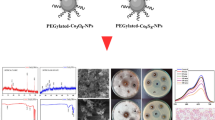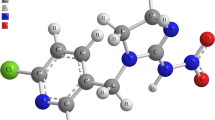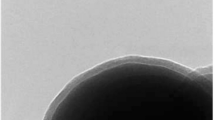Abstract
By industrialization, management of water resources is known as one of the most challenging issues for human society due to the presence of various contaminants such as oil, azo dyes, and micropollutants in water. The treatment of wastewaters containing more than one type of pollutants via a single-step process cannot be performed by a simple adsorption process. In this study, by combining the advantages of superparamagnetic iron oxide, carboxymethyl-β-cyclodextrin polymer, and N-heterocyclic palladium complex, a versatile bi-functionalized iron oxide nanoadsorbent [Fe3O4@CM-β-CDP@Tet-Pd] was fabricated for the capture of toxic dyes in wastewater. The structure of nanoadsorbent was characterized by Fourier transform infrared spectroscopy, X-ray diffraction, scanning electron microscopy, transmission electron microscopy, thermogravimetric analysis, and vibrating sample magnetometer analysis. Afterward, the catalytic activity of the synthesized nanoadsorbent was examined in the aqueous solution of sodium borohydride as the reducing agent for rhodamine B, methylene blue, 4-nitrophenol, Metanil yellow, and Eosin Y. The UV-vis spectroscopy was used to monitor the catalytic activity of the [Fe3O4@CM-β-CDP@Tet-Pd] in an aqueous medium. The nanoadsorbent was successfully recovered and re-used six times, without remarkable loss in its catalytic activity. These results showed that the combination of iron oxide nanoparticles with carboxymethyl-β-cyclodextrin polymer provides a promising well-performed and easily recyclable nanoadsorbent for dye uptake and wastewater treatment.












Similar content being viewed by others
References
Al-Abdallat Y, Jum’h I, Al Bsoul A et al (2019) Photocatalytic degradation dynamics of methyl orange using coprecipitation synthesized Fe 3 O 4 nanoparticles. Water Air Soil Pollut 230:277
Asadabadi AZ, Hoseini SJ, Bahrami M, Nabavizadeh SM (2019) Catalytic applications of β-cyclodextrin/palladium nanoparticle thin film obtained from oil/water interface in the reduction of toxic nitrophenol compounds and the degradation of azo dyes. New J Chem 43:6513–6522
Attarchi N, Montazer M, Toliyat T (2013) Ag/TiO2/β-CD nano composite: preparation and photo catalytic properties for methylene blue degradation. Appl Catal A Gen 467:107–116
Badruddoza AZM, Shawon ZBZ, Tay WJD, Hidajat K, Uddin MS (2013) Fe3O4/cyclodextrin polymer nanocomposites for selective heavy metals removal from industrial wastewater. Carbohydr Polym 91:322–332
Brusseau ML, Wang X, Wang W-Z (1997) Simultaneous elution of heavy metals and organic compounds from soil by cyclodextrin. Environ Sci Technol 31:1087–1092
Campos AFC, de Oliveira HAL, da Silva FN, da Silva FG, Coppola P, Aquino R, Mezzi A, Depeyrot J (2019) Core-shell bimagnetic nanoadsorbents for hexavalent chromium removal from aqueous solutions. J Hazard Mater 362:82–91
Chaplin BP, Reinhard M, Schneider WF, Schüth C, Shapley JR, Strathmann TJ, Werth CJ (2012) Critical review of Pd-based catalytic treatment of priority contaminants in water. Environ Sci Technol 46:3655–3670
Chen L, Berry RM, Tam KC (2014) Synthesis of β-cyclodextrin-modified cellulose nanocrystals (CNCs)@ Fe3O4@ SiO2 superparamagnetic nanorods. ACS Sustain Chem Eng 2:951–958
Crini G, Lichtfouse E (2019) Advantages and disadvantages of techniques used for wastewater treatment. Environ Chem Lett 17:145–155
Del Valle EMM (2004) Cyclodextrins and their uses: a review. Process Biochem 39:1033–1046
Demangeat E, Pédrot M, Dia A, Bouhnik-le-Coz M, Grasset F, Hanna K, Kamagate M, Cabello-Hurtado F (2018) Colloidal and chemical stabilities of iron oxide nanoparticles in aqueous solutions: the interplay of structural, chemical and environmental drivers. Environ Sci Nano 5:992–1001
Dutt S, Siril PF, Sharma V, Periasamy S (2015) Gold core–polyaniline shell composite nanowires as a substrate for surface enhanced Raman scattering and catalyst for dye reduction. New J Chem 39:902–908
Fedoročková A, Sučik G, Raschman P (2016) Activated zeolite and magnesite as potential reactive materials for passive acidic groundwater treatment technology. Solid State Phenomena. Trans Tech Publ, In, pp 221–227
Fernández M, Villalonga ML, Fragoso A, Cao R, Baños M, Villalonga R (2004) α-Chymotrypsin stabilization by chemical conjugation with O-carboxymethyl-poly-β-cyclodextrin. Process Biochem 39:535–539
Fuentes-García JA, Diaz-Cano AI, Guillen-Cervantes A, Santoyo-Salazar J (2018) Magnetic domain interactions of Fe 3 O 4 nanoparticles embedded in a SiO 2 matrix. Sci Rep 8:1–10
Fuhrer R, Herrmann IK, Athanassiou EK, Grass RN, Stark WJ (2011) Immobilized β-cyclodextrin on surface-modified carbon-coated cobalt nanomagnets: reversible organic contaminant adsorption and enrichment from water. Langmuir 27:1924–1929
Gan Z, Zhao A, Zhang M, Tao W, Guo H, Gao Q, Mao R, Liu E (2013) Controlled synthesis of Au-loaded Fe 3 O 4@ C composite microspheres with superior SERS detection and catalytic degradation abilities for organic dyes. Dalton Trans 42:8597–8605
Gandha K, Mohapatra J, Hossain MK, Elkins K, Poudyal N, Rajeshwar K, Liu JP (2016) Mesoporous iron oxide nanowires: synthesis, magnetic and photocatalytic properties. RSC Adv 6:90537–90546
Ghasemi M, Mashhadi S, Azimi-Amin J (2018) Fe3O4/AC nanocomposite as a novel nano adsorbent for effective removal of cationic dye: process optimization based on Taguchi design method, kinetics, equilibrium and thermodynamics. J Water Environ Nanotechnol 3:321–336
Ghosh SK, Mandal M, Kundu S et al (2004) Bimetallic Pt–Ni nanoparticles can catalyze reduction of aromatic nitro compounds by sodium borohydride in aqueous solution. Appl Catal A Gen 268:61–66
Ghosh S, Badruddoza AZM, Uddin MS, Hidajat K (2011) Adsorption of chiral aromatic amino acids onto carboxymethyl-β-cyclodextrin bonded Fe3O4/SiO2 core–shell nanoparticles. J Colloid Interface Sci 354:483–492
Guivar JAR, Bustamante A, Gonzalez JC et al (2018) Adsorption of arsenite and arsenate on binary and ternary magnetic nanocomposites with high iron oxide content. Appl Surf Sci 454:87–100
Hao L-Y, Zhu C-L, Jiang W-Q, Chen CN, Hu Y, Chen ZY (2004) Sandwich Fe 2 O 3@ SiO 2@ PPy ellipsoidal spheres and four types of hollow capsules by hematite olivary particles. J Mater Chem 14:2929–2934
Harish S, Mathiyarasu J, Phani KLN, Yegnaraman V (2009) Synthesis of conducting polymer supported Pd nanoparticles in aqueous medium and catalytic activity towards 4-nitrophenol reduction. Catal Lett 128:197–202
Hatamifard A, Nasrollahzadeh M, Sajadi SM (2016) Biosynthesis, characterization and catalytic activity of an Ag/zeolite nanocomposite for base-and ligand-free oxidative hydroxylation of phenylboronic acid and reduction of a variety of dyes at room temperature. New J Chem 40:2501–2513
Heydari A, Sheibani H (2015) Fabrication of poly (β-cyclodextrin-co-citric acid)/bentonite clay nanocomposite hydrogel: thermal and absorption properties. RSC Adv 5:82438–82449
Heydari A, Doostan F, Khoshnood H, Sheibani H (2016) Water-soluble cationic poly (β-cyclodextrin-co-guanidine) as a controlled vitamin B 2 delivery carrier. RSC Adv 6:33267–33278
Heydari A, Pardakhti A, Sheibani H (2017) Preparation and characterization of Zwitterionic Poly (β-cyclodextrin-co-guanidinocitrate) hydrogels for ciprofloxacin controlled release. Macromol Mater Eng 302:1600501
Heydari A, Sheibani H, Hronský V, Janigová I, Šlouf M, Šiffalovič P, Chodák I (2018) β-Cyclodextrin-epichlorohydrin polymer/graphene oxide nanocomposite: preparation and characterization. Chem Pap 72:1299–1313
Islam M, Mondal P, Roy AS, Tuhina K (2010) Synthesis, characterization and catalytic activities of a reusable polymer-anchored palladium (II) complex: effective catalytic hydrogenation of various organic substrates. Transit Met Chem 35:427–435
Kabir SMF, Sikdar PP, Haque B, Bhuiyan MAR, Ali A, Islam MN (2018) Cellulose-based hydrogel materials: chemistry, properties and their prospective applications. Prog Biomater 7:153–174
Kang Y, Zhou L, Li X, Yuan J (2011) β-Cyclodextrin-modified hybrid magnetic nanoparticles for catalysis and adsorption. J Mater Chem 21:3704–3710
Kumar A, Belwal M, Maurya RR et al (2019) Heterogeneous catalytic reduction of anthropogenic pollutant, 4-nitrophenol by Au/AC nanocatalysts. Mater Sci Energy Technol 2:526–531
Lakouraj MM, Norouzian R-S, Balo S (2015) Preparation and cationic dye adsorption of novel Fe3O4 supermagnetic/thiacalix [4] arene tetrasulfonate self-doped/polyaniline nanocomposite: kinetics, isotherms, and thermodynamic study. J Chem Eng Data 60:2262–2272
Marchesini FA, Irusta S, Querini C, Miró E (2008) Nitrate hydrogenation over Pt, In/Al2O3 and Pt, In/SiO2. Effect of aqueous media and catalyst surface properties upon the catalytic activity. Catal Commun 9:1021–1026
Nasrollahzadeh M, Issaabadi Z (2019) Reduction of Cr (VI) and 4-nitrophenol in aqueous media using N-heterocyclic palladium complex immobilized on the nano Fe3O4@ SiO2 as a magnetically recyclable catalyst. Sep Purif Technol 211:809–815
Nasrollahzadeh M, Issaabadi Z, Safari R (2019) Synthesis, characterization and application of Fe3O4@ SiO2 nanoparticles supported palladium (II) complex as a magnetically catalyst for the reduction of 2, 4-dinitrophenylhydrazine, 4-nitrophenol and chromium (VI): A combined theoretical (DFT) and experi. Sep Purif Technol 209:136–144
Pathania D, Katwal R, Sharma G, Naushad M, Khan MR, al-Muhtaseb A’H (2016) Novel guar gum/Al2O3 nanocomposite as an effective photocatalyst for the degradation of malachite green dye. Int J Biol Macromol 87:366–374
Peik-See T, Pandikumar A, Ngee LH, Ming HN, Hua CC (2014) Magnetically separable reduced graphene oxide/iron oxide nanocomposite materials for environmental remediation. Catal Sci Technol 4:4396–4405
Plesingerova B, Fedoročková A, Jádi N, Sučik G (2015) Comparison of the ability of limestone and concrete to remove heavy metal ions from contaminated water. Acta Metall Slovaca 21:236–246
Ramalingam B, Khan MMR, Mondal B, Mandal AB, Das SK (2015) Facile synthesis of silver nanoparticles decorated magnetic-chitosan microsphere for efficient removal of dyes and microbial contaminants. ACS Sustain Chem Eng 3:2291–2302
Ramos-Guivar JA, Taipe K, Schettino MA et al (2020) Improved removal capacity and equilibrium time of maghemite nanoparticles growth in zeolite type 5A for Pb (II) adsorption. Nanomaterials 10:1668
Ramos-Guivar JA, Gonzalez-Gonzalez JC, Litterst FJ, Passamani EC (2021a) Rietveld refinement, μ-Raman, X-ray photoelectron, and Mössbauer studies of metal oxide-nanoparticles growth on multiwall carbon nanotubes and graphene oxide. Cryst Growth Des 21:2128–2141
Ramos-Guivar JA, López EO, Greneche J-M, Jochen Litterst F, Passamani EC (2021b) Effect of EDTA organic coating on the spin canting behavior of maghemite nanoparticles for lead (II) adsorption. Appl Surf Sci 538:148021
Rebodos RL, Vikesland PJ (2010) Effects of oxidation on the magnetization of nanoparticulate magnetite. Langmuir 26:16745–16753
Sajjadi M, Nasrollahzadeh M, Tahsili MR (2019) Catalytic and antimicrobial activities of magnetic nanoparticles supported N-heterocyclic palladium (II) complex: a magnetically recyclable catalyst for the treatment of environmental contaminants in aqueous media. Sep Purif Technol:115716
Shannon MA, Bohn PW, Elimelech M et al (2010) Science and technology for water purification in the coming decades. In: Nanoscience and technology: a collection of reviews from nature. Journals World Scientific:337–346
Švandová M, Raschman P, Sučik G et al (2015) Removal of heavy metals from wastewater using caustic calcined magnesia. Acta Metall Slovaca 21:247–252
van Leeuwen DA, Van Ruitenbeek JM, De Jongh LJ et al (1994) Quenching of magnetic moments by ligand-metal interactions in nanosized magnetic metal clusters. Phys Rev Lett 73:1432–1435
Wang Z, Xu C, Gao G, Li X (2014) Facile synthesis of well-dispersed Pd–graphene nanohybrids and their catalytic properties in 4-nitrophenol reduction. RSC Adv 4:13644–13651
Xu P, Zeng GM, Huang DL, Feng CL, Hu S, Zhao MH, Lai C, Wei Z, Huang C, Xie GX, Liu ZF (2012) Use of iron oxide nanomaterials in wastewater treatment: a review. Sci Total Environ 424:1–10
Xuan S, Wang Y-XJ YJC, Leung KC-F (2009) Preparation, characterization, and catalytic activity of core/shell Fe3O4@ polyaniline@ Au nanocomposites. Langmuir 25:11835–11843
Yang X, Zhong H, Zhu Y, Jiang H, Shen J, Huang J, Li C (2014a) Highly efficient reusable catalyst based on silicon nanowire arrays decorated with copper nanoparticles. J Mater Chem A 2:9040–9047
Yang Z, Zhang X, Cui J (2014b) Self-assembly of bioinspired catecholic cyclodextrin TiO2 heterosupramolecule with high adsorption capacity and efficient visible-light photoactivity. Appl Catal B Environ 148:243–249
Yuan J, Liu X, Akbulut O, Hu J, Suib SL, Kong J, Stellacci F (2008) Superwetting nanowire membranes for selective absorption. Nat Nanotechnol 3:332–336
Zhang B, Zhao B, Huang S, Zhang R, Xu P, Wang HL (2012) One-pot interfacial synthesis of Au nanoparticles and Au–polyaniline nanocomposites for catalytic applications. Cryst Eng Comm 14:1542–1544
Zhao F, Repo E, Yin D, Meng Y, Jafari S, Sillanpää M (2015) EDTA-cross-linked β-cyclodextrin: an environmentally friendly bifunctional adsorbent for simultaneous adsorption of metals and cationic dyes. Environ Sci Technol 49:10570–10580
Zhu Y, Zhou X, Chen D, Li F, Xue T, Farag AS (2017) Ternary Fe 3 O 4@ PANI@ Au nanocomposites as a magnetic catalyst for degradation of organic dyes. Sci China Technol Sci 60:749–757
Acknowledgements
ZML acknowledge the SAIA, n. o. (Slovak Academic Information Agency) for support on the experiment provided.
Availability of data and materials
Not applicable.
Funding
This work was financially supported by the Iran National Science Foundation (grant number 97003938) and the Slovak Grant Agency VEGA 2/0140/20. ZML is financially supported by the National Scholarship Programme of the Slovak Republic (NSP).
Author information
Authors and Affiliations
Contributions
Zohreh Mehri Lighvan: conceptualization, investigation, resources, visualization, software, writing—original draft. Hossein Ali Khonakdar: investigation, resources, and writing—reviewing and editing. Abolfazl Heydari: resources, software, and writing—reviewing and editing. Ali Akbari: investigation and writing—reviewing and editing. Miroslav Šlouf: methodology. All authors read and approved the final manuscript.
Corresponding authors
Ethics declarations
Ethics approval and consent to participate
Not applicable.
Consent for publication
Not applicable.
Competing interests
The authors declare no competing interests.
Additional information
Responsible Editor: Angeles Blanco
Publisher’s note
Springer Nature remains neutral with regard to jurisdictional claims in published maps and institutional affiliations.
Rights and permissions
About this article
Cite this article
Lighvan, Z.M., Khonakdar, H.A., Heydari, A. et al. A versatile β-cyclodextrin and N-heterocyclic palladium complex bi-functionalized iron oxide nanoadsorbent for water treatment. Environ Sci Pollut Res 28, 55419–55432 (2021). https://doi.org/10.1007/s11356-021-14814-5
Received:
Accepted:
Published:
Issue Date:
DOI: https://doi.org/10.1007/s11356-021-14814-5




